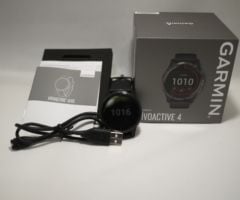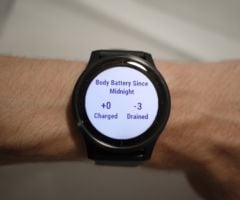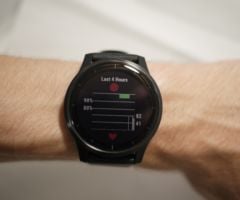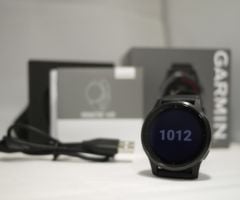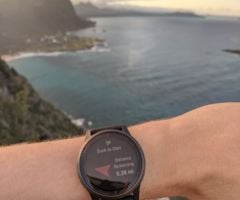Review: Garmin VivoActive 4
This expert review is written by
Frank May
Fast Runner, Triathlete and EngineerToday Deals
Quick overview
Brand
Model
List price
Battery life
Water proof
Multi sport
Music support
24h tracking
Heart monitor
Route
Pros and cons according to our running expert
Pros and cons according to our running expert
- Sleek and subdued design
- Garmin Pay and Music in the watch
- Great sensor set (heart rate, pulse ox, etc.)
- Touch screen with sweaty hands is tough to use
- Garmin intentionally kept features (live map of your route, courses) from the watch to persuade you to the Fenix or Forerunner lines
- Still some bugs in the software
- No wireless charging
Our verdict
Part of the Garmin’s strategy to do just enough in all the categories is part of the problem.I think that the vivoactive 4 is an incredible smartwatch for most anyone that wants one, but it sacrifices a bit on both the smartwatch and “activewatch” fronts. The UI and screen is not as snappy and beautiful as what Apple and Samsung can do, nor can it handle an open water swim or navigate a hike like a Fenix or Suunto. I still strongly recommend this watch, but only to those who just want to add some workouts to their week and don’t want a second watch for that.
Design and Hardware Garmin VivoActive 4
Garmin has been slowly moving towards the premium activity tracking market with their vivo series of watches, and it’s clear with the fully circular touch screen wrapped in a metal band that Garmin is ready to take the lead.
Back when I had a vivoactive HR, I knew Garmin had the vision to make something perfect for daily wear and workout tracking, but disliked the slow UI and bulky design. Since then, Garmin has slimmed down the design to the point where it looks just like any other watch out there.
Now this is a polarizing opinion, and somewhat contradictory to my earlier praises that Garmin made this watch look like a normal watch: I think we should get rid of the circular watch design. It’s a holdover from an era that needed space to rotate arms and I think the main reason Garmin moved from the square shape to the circular shape was aesthetics. Your phone+computer+TV are all rectangular, most the screens on the watch are rectangular boxes or square, and circular edges of the watch extend past the band which adds minor constraints to wrist movement.
But, I know everyone else* (*besides Apple) is doing circular, so this complaint is more of a frustration that Garmin started out with a square design and moved to circular with the vivoactive line.
That circular screen does house a good display. It’s a 260×260 display with good visibility in direct sunlight and only minor whitewashing effects if you view it at steep angles with the backlight.
The responsiveness of the display is also a strong point for the watch, as it feels much more in line with a smartphone than previous Garmin touch devices.
The vivoactive HR’s touchscreen felt more like I was suggesting the watch move to a new screen instead fluidly scroll like I can with the vivoactive 4. But, just like a smartphone, the touch screen on this watch doesn’t work well when wet. That’s a real problem when using this when working out, and a dealbreaker for some serious athletes.
I found the addition of the two side buttons to make it ok, but can’t tell you how many times I was in a run and just wanted to change the screen and ended up accidentally swiping in the clock or getting stuck somewhere due to sweaty fingers
Now my complaints with the shape and touchscreen are useless to you if you are comparing this to other daily activity trackers, as they pretty much all have circular touchscreens.
What should really matter then is the Garmin hardware inside. As far as I can tell, you’re getting the same Pulse Ox and heart rate sensor that’s in the premium Fenix watch, and probably very similar GPS+Glonass+Galileio positioning sensors as the Forerunner and Fenix line.
This means your runs/bikes/walks in this vivoactive watch will be so much more data rich than the competitors. There’s also a lot more useful hardware in the watch, but I’ll review those in later sections.
Navigating the Interface Garmin VivoActive 4
The basic navigation of the vivoactive 4 is split between touch-based controls, and button based controls. Most screen navigation is done by swiping up/down/left/right, and most action items are done by pressing the up or down buttons. From the clock on the home screen, you can start a workout by pressing the start button, or swipe up/down to access your health stats+notifications.
For the most part, I found I could navigate the watch without much thinking after a few days and started to take advantage of shortcuts, like adding the music controller to the “swipe left” at home.
The touchscreen also made menu navigation much more intuitive, which is a huge advantage of the vivoactive over button-based watches since I find that friends/family new to high tech watches get overwhelmed with button combinations to access screens.
Garmin has done a pretty good job at deciding what should be a button and what should be a touch button/action, although I think they have a little room to improve. For example, you can start and stop a workout with the upper right button, but need to use the touch screen to save/delete the workout.
Sounds simple, until you look at the “delete” icon at the top of the touch screen beneath an upward curved segment, and the “save” icon at the bottom below a downward curved segment. There are no virtual button areas, so it may seem this is asking you to swipe up to delete, down to save, but doing that does the opposite of what you want as those “swipe” areas are actually buttons.
Considering garmin uses the same curved segments on other screens to indicate you can swipe to access that area, this UI navigation discrepancy shows they have some problems.
For the most part though, I found after myself missing the use of buttons when in workouts, and loving the touch screen when not in workouts.
This makes me think/hope that garmin will introduce a Forerunner or Fenix watch in the future that will have both touch and buttons with the ability to chose either.
On the run Garmin VivoActive 4
Garmin’s position tracking sensor suite means you’ll often find GPS within seconds (especially after your first use of the watch in an area). I’ve done runs with the vivoactive on one arm, and a Fenix 6 or Forerunner 935 on the other arm and had the vivoactive get a satellite lock just a second or two after the Fenix or Forerunner.
One gripe starting the run though is you have to first press the start button to access your activities, then switch to the touchscreen to tap the run icon (which is pretty small so you better not be walking/moving much), then tap the start button again. Why not have the first start press go to the activity screen, second start press select the first activity, and third start button press begin the activity?
Regardless of how you begin the run, you’ll have access to most of Garmin’s running metrics. You can have up to 3 screens + HR gauge with up to 4 data metrics per screen. The list of metrics you can display include the basics like distance, time, pace, heart rate, lap data, averages, and also include more detailed running metrics you may not find in other watches like cadence, temperature, accents data, and heading.
Although it’s intuitive to swipe up/down to change screens, it’s frustrating to drag your finger along the screen to see it didn’t respond to the touch input, and even more frustrating when it’s cold out and you just wanna keep your gloves on and change the screen so you end up using your nose and look like a fool sniffing your wrist.
And good luck if it’s raining on your run and you want to easily change screens. But Garmin knows this watch isn’t for the hardcore runner, so maybe those few situations you can’t easily change screens isn’t a big deal.
Onto a few unique features of this watch for runners. The music playing abilities of this watch are pretty great. It’s freeing to just bring a watch and bluetooth headphones on your run (and I’ll go into more details on the music later).
Another freeing feeling is knowing you can always grab a drink at a store that accepts contactless payments without needing a wallet by using Garmin Pay. Those two features alone might be enough to convince users of older Garmin watches to switch to the vivoactive 4. Now I wish I could say the same about Pulse Ox (Garmin’s estimate of your O2 saturation), but the reading requires a steady, almost limp, hand with a tight fit for at least 10 seconds. This isn’t something you can take advantage of during your runs unless you stop.
Now here’s a little conspiracy theory for you. This watch knows your GPS location, can tell you the distance you’ve done, can display a map of where you’ve gone as a summary when you finish, and has GIGABYTES of storage space.
So why can’t it display where you’ve gone on a map when you’re running? This isn’t a software limitation as it shows you the map when you finished, and can’t be a hardware limitation as my more than 10 year old Forerunner 305 could show a live map and this vivoactive has enough processing power to play music over Bluetooth.
It should follow that it’s also odd you can’t import a course and follow it. What I think is going on is Garmin intentionally software locked out those features from this watch since adding them in would make it compete too closely with their more expensive Forerunner and fenix lines. Now this is all speculation on my end, but I believe it enough to consider this a sizeable con to the watch and to the company.
After the run: software and connectivity Garmin VivoActive 4
You get a great set of options to sync your data. Do it the old fashioned way with the cable. Try something more modern like sync the workout data over bluetooth to your phone. Or really embrace technology and give you watch your wifi password so it can sync anytime you’re near home.
Once the data goes to the Garmin cloud, you can use Garmin Connect to check out your workout data (which easily shares data to third party sites if you choose like Strava). I found Garmin Connect to be very useful at parsing through the almost overwhelming amount of activity data this watch pumps out. Heart rate vs. time is now childs play to Garmin, as they have a daily summary of your activities, stress, pulse ox, body battery, and weekly trends organized on easy to access pages.
Now I’m like many athletes out there that let the syncing happen and then check Strava for the summary, so I was surprised when I saw that the data on Garmin Connect was much more detailed. I suppose it makes sense that Strava does not want to store all the data, but good to know if you’re a Stravaholic and want to get every last ounce of data analysis out of your workout.
One last key point about data. This is your body and location data, pretty private stuff. So it makes sense you should be able to share or not, and download it or not, and delete it or not if you want. Garmin allows that without needing you to jump through hoops.
Other activities Garmin VivoActive 4
As a runner dabbling in the triathlon world and waiting for T2, I’ve tested the bike and swim features on this watch pretty regularly.
It’s disappointing this watch doesn’t do open water swim tracking (you can start a “walk” and get a rough distance idea that way), but it’s nice they at least have an indoor pool lap tracker. Useful enough to get a basic lap count in, and pretty accurate as long as you have a clear flip or turn off the wall for the watch to look for. Over a 100 lap workout, I’ll see mabe 1-2 laps that are missed, and generally 1-2 laps that are double counted which works out in the end for counting laps, but screws up pacing sometimes.
The bike has pretty much the same data features as running, but also lets you pair with a speed and cadence sensor. I own a smart trainer, so it’s able to get a rough idea of your workout through that. However, my smart trainer also broadcasts power data which is much more valuable than speed+cadence, yet the vivoactive 4 didn’t pick up that sensor. Maybe I missed a setting, but it’s curious that my Fenix 6 found the power sensor. Either way, you’re likely not buying a vivoactive 4 if you own a power sensor :).
Although the watch has many other activities (XC Ski, Golf, Pilates, Stair stepper…), I don’t have enough time to get into all of them but want to bring attention to one last set: Breathwork, Yoga/Pilates, Strength.
Garmin stepped up their game from just timed based activities with some labels to full on animations and guides on how to do the workout.
I’m not someone who gets into new routines that easily, but found myself just trying stuff like their “Pilates On The Road” workout and it felt like a little youtube animation tutorial right on my wrist. Really like this use of animations to help teach activities!
Accuracy and battery life Garmin VivoActive 4
As someone with too many watches and an interest in big data, I frequently take the vivoactive 4 out on workouts with another watch on the same wrist (or that one time I did a half ironman with the vivoactive and 3 other watches).
In summary, the vivoactive 4 is more than enough accurate for a recrational jogger or cyclist. It’s even accurate enough to challenge the Forerunner and fenix line of watches.
I did find on a few tests the vivoactive was off by 0.01, but this was not too frequent and I didn’t get into scientific testing. So in summary, the accuracy of position+speed+time data is very good.
The accuracy of wrist based heart rate on the other hand, or rather on the hand you wear it, is ok. Like all Garmin watches that used wrist based heart rates, you’ll have a lot of things that can make it less accurate like: watch too lose, watch too tight, skin too cold, skin too hairy, too much vibration on arm.
Always go for a chest worn heart rate monitor if you really want accurate heart rate data, as the wrist based data is often +/-10% off, and has serious data smooothing issues. Like don’t count on this watch to detect a sudden 120bpm to 170 bpm sprint spike over 5 seconds back down to 120 bpm. What the watch will say each second over those 5 seconds will probably be 120,120,125,130,150 when in reality it’s 120,150,170,140,130.
Battery life really depends on what features you have turned on and off. If you just have the watch on your wrist tracking heart rate and use it occasionally to check daily stats, you’ll see it last 5 or so days. Garmin claims up to 8 days in smartwach mode, so maybe their test is just leaving the watch on a table or not touching it much during the day.
What’s more important is how long can you go in between charges if you use the watch a few times each week with GPS on for an hour or so, maybe with music streaming sometimes, and have Pulese Ox turned on during the day to check your estimated O2 saturation. My testing shows 4 or so days for all that.
But what if you want to know the maximum GPS on time for the watch? I ran some tests of my own (put the watch with GPS on infront of a security camera) and found the watch with just GPS lasts a little over 24 hours, more than what Garmin claims (18 hours), but that makes sense since my wath wasn’t on a wrist.
If you also turn music on, Garmin claims you can do up to 6 GPS+Music hours, and my testing found the watch died after 6.5 hours. Not a good watch to pick if you’re into ultra running, long hikes, or Ironman races, but Garmin knows that and have a few other watches for those folks.
Other interesting functions Garmin VivoActive 4
Few notable features of the vivoactive watch that I want to go into more detail are the body battery, stress level, Garmin Pay, and Music.
The Body Battery indicator is a somewhat gimmicky term for what can be a useful feature. As the name implies, it estimates the energy your body has. As you sleep, it goes up, as you’re awake, it goes down, and as you workout, it drops even faster. The question is, if you feel great but see your body battery is low, do you rethink how you feel and try to figure out if you should feel more tired? This kind of open loop body feedback is a little risky if you take it too seriously, but I like the concept and find it to be a good indicator of “will I have a good workout today?” since it can remind you of how long you’ve been up and how much you’ve slept + if you’ve already done a workout.
The stress level indiator is similar to the body battery metric, but takes in your heart rate variability along with many other actual scientific data points the watch measures to try to figure out if you’re stressed or relaxed. I laughed at the feature when I first tried it, figured I’d turn on “stress notifications” because it’d be silly for a watch to tell me when I’m stressed.
Then I forgot about it for a few days until I finished a meeting at work and was late to a check in with a coworker as my phone buzzed from a client and I just wanted to get a snack from the kitchen. A familiar buzz rattled my wrist and I looked at the screen to see what other notification I now had to deal with and it was instead a kind message saying “you seem stressed, do you want to take time to relax?”. I stopped what I was doing and just thought to myself, “you know what, yes, I am stressed, I should calm down. Thank you Garmin!”
Now this doesn’t make up for the many times it gives me false positives, like when really getting into techno on my drive to work, or when hanging out with friends and getting excited over a topic, but it really shows Garmin getting into new data-driven health analytics that I think will be pretty useful when polished.
Last two features to get into are Garmin pay and the music feature. Garmin pay lets you link a card to your watch, and after setting it up via the Garmin Connect app and adding a pin code, you can use your watch on any NFC compatible payment device to pay for your purchase. This was my fist time using a watch to pay for something, and I found myself using it just for the novelty. Now in the era of “don’t touch things”, I find myself using it a little more. Pretty useful, and even nicer to have it on runs/bikes.
Last but not least is the music playing abilities of this watch. You can sync Spotify, Deezer, several other apps, and even load the watch directly with MP3 files. You will need a bluetooth headset to play the music from, but it’s pretty simple once it’s working. Play/pause, next/previous tracks all available via touch on your wrist.
Garmin claims the watch can hold “up to 500 songs”, which translates to 3.5 GB of space. Overall, the feature works as described. I’m a picky audio person (you know the word), so Bluetooth streaming isn’t my top choice, but you can’t be picky when running. What does irk me is that the headphone+watch combo I use often cuts out a few times during an hour.
Although this is like 99.99% perfect, it totally breaks the immersion in a song when it skips a half a second and you know you’ll hear another skip in a bit. I generally use Air by AfterShockz which are pretty premium, and have tried other cheaper buds, and the cutting out/skipping problem still shows up. Maybe it’s because I’m 6’3″ and have a long distance between my wrist and head, but I really wish this could be 100% perfect
Conclusion Garmin VivoActive 4
Overall, this watch is worth the money, but only to those who primarily want a smartwatch that has good workout features and not vice-versa.
I think it’s worth the upgrade from the previous model as well, and think the strength of the Garmin ecosystem paired with the proven Garmin hardware makes this a solid choice when compared to competitors like Apple and Samsung.
Price comparison:
Garmin VivoActive 4
This page contains affiliate links. As an Amazon Associate I earn from qualifying purchases.
Today Deals
Write a review
About the Garmin VivoActive 4
Your review was successfully posted.
If your review wins, you will get a notification by email.
Winner will receive Amazon gift card of $50 or equivalent in other currency.
Ask a question
About the Garmin VivoActive 4
Your question was successfully sent.
Similar watches to Garmin VivoActive 4


Garmin Forerunner 265


Coros Pace 3













